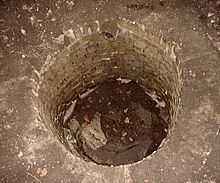Septic tank
The septic tank or septic tank is a septic tank for rainwater infiltration or for the autonomous drainage of black water or sewage .
design type
The design ranges from simple pits to seepage shafts made of precast concrete parts .
function
In many countries in rural areas, the disposal of human excrement and sometimes sewage via septic tanks is the norm (e.g. USA, Canada, France, Spain). Depending on the design, they can also be operated with water flush. Most of the time, septic tanks require an outhouse . The excrement then ends up either directly or through pipes in a dug pit with a porous subsoil, usually normal soil. Urine and other liquids seep into the floor and walls, leaving only a solid, rotting mass made up of feces, toilet paper and the like. When the pit is filled to a certain level, it is pumped out or filled with earth and a new pit is dug elsewhere. A septic tank with a " thunder bar" on top is the simplest form of a toilet .
In Germany and in many other countries, septic tanks are now only used to infiltrate rainwater for environmental reasons; the discharge of domestic waste water is usually no longer permitted. The public sewer system , previously also septic tanks (the simplest form of a small sewage treatment plant , which has not been permitted since 2015) is used for this purpose. Another alternative are sewage collection pits, in which the sewage is merely collected and, as soon as the pit is filled, it is removed by a special suction vehicle. In contrast to the septic tank, a septic tank has tight walls and an impermeable floor, since the sewage should not seep away. Colloquially, however, there is often no distinction between septic tanks, septic tanks and septic tanks.
archeology
In the archaeological area, historical septic tanks under an outhouse are known as cesspools. During the Middle Ages and early modern times , in addition to their function as toilets, they were also used in cities to dispose of all kinds of waste. During excavations , everyday objects are therefore often found in them. These include mainly ceramic and glass finds. In many cases there are excellent conservation conditions for organic materials (e.g. wood, leather) in sewers, so that everyday objects can be salvaged from them that would otherwise not have survived. The conservation is due to the location in the area of influence of the groundwater and the compact storage of the faecal layers. Since there is no ventilation, the decomposition of the sewer sediments is inhibited.
See also
Web links
Individual evidence
- ↑ Pollen from the “quiet village” ( memento of the original from March 17, 2016 in the Internet Archive ) Info: The archive link was inserted automatically and has not yet been checked. Please check the original and archive link according to the instructions and then remove this notice. at Lüneburger Stadtarchäologie eV
